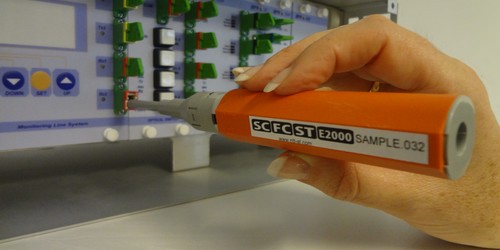Standard Balunok
Jellemzők
2 and 8Mbit/s 75/120Ω Transmission Baluns
(Identify by black coloured outer body insulation ring)
Electrical Characteristics and Performance:
- Performance exceeds ITU.G.703
- The value of impedance match is 75 ± 3Ω resistive to 120 ± 4Ω resistive, when measured from 51 to 12,672kHz with the unused end terminated into the respective resistive load.
- The insertion loss from both sides is < 0.2dB for 2Mbit/s and < 0.3dB for 8Mbit service.
- Cross talk between any two baluns mounted on a DDF strip with 15mm centres is better than -80dB in the frequency range of 0.1MHz to 12MHz.
- Return loss is – 29dB(typ) for 2Mbit/s and –21dB(typ) for 8Mbit/s service
- Transmission losses for cable are excluded.
2, 8 and 34Mbit/s 75/120Ω Transmission Baluns
Identifiable by its outer body insulating ring which is coloured white.
Electrical characteristics and performance
- The value of the impedance match is 75 ± 10Ω resistive to 120 ± 12Ω resistive, when measured at 1 to 17MHz and with the unused end terminated into the respective resistive load.
- The insertion loss less than 0.9dB is in the range 0.2MHz to 70MHz from both sides.
- Cross talk between any two baluns mounted on a DDF strip is better than -60dB with vertical orientation of IDC connectors in the range of 1MHz to 70MHz
- Return loss is better than -15dB in the frequency range of 1MHz to 70MHz in both directions of transmission conforming to ITU-G.703.
- Transmission losses for cable are excluded.
Alkalmazás
BALUN is a word derived from terms applied to BALanced to UNbalanced transmission lines, and generally refers to an impedance matching device for interfacing two lines having different characteristic impedance and often one balanced line to one unbalanced line. (There are devices called UNUN’s, they are unbalanced to unbalanced devices.)
The balanced lines normally refer to twisted pair cables and the unbalanced lines to coaxial cables due to the way the cables are designed. The balun device generally consists of a radio frequency transformer having two windings matching the respective impedance of the lines. Often tuned to provide optimum matching, maximum return loss, minimum insertion loss and other frequency characteristics. Fitted with some type of connecting terminals for the balanced twisted pair end and a coaxial connector at the unbalanced coaxial end. Sometimes they also include voltage surge suppression components.
Physical Characteristics
- Intended for panel mounting and can be supplied with a variety of Coaxial Connectors BNC, 1.6/5.6, Type43, BPO10 etc
- Twisted pair termination via 3 pole Krone IDC
- Available in two speed ranges 2-8Mbit/s and 2-8-34Mbit/s
- The coaxial side is designed for DDF (1.6/5.6 connectors or similar) installation and for equipment connection (cable integral) with either male or female connectors
- The mechanical endurance of the coaxial connectors is designed to give in excess of 500 connect/disconnect cycles.
- On the balanced side, the 120Ω interface connector is designed to accept termination of single and multi-strand conductors with nominal diameters from 0.4mm to 0.65mm.
- The force required to terminate the IDC is designed to remain fully operative and intact after 50 connect/reconnect cycles for Krone IDC Terminals
- Simple cable anchorage is achievable by passing the cable through the hollow section under terminal markings.
Standard Balun Termination Procedure
1. Mount the balun to the panel (if applicable).
2. Strip the cable sheath to expose the individual twisted pairs (if applicable)
3. Pass the desired twisted pair through the cable restraint hole in the moulding entering at ’A‘
4. Loop the wires back over and into the appropriate slot in the IDC connector.
5. The IDC marked ’A‘ corresponds with the centre contact in the coax connector, ’B‘ corresponds to the outer contact and ‘E’ earth.
6. Terminate the IDC using a Krone terminating tool.
7. Dress the cables as shown in the diagram below, allowing a loop of about 25mm at the cable entry in case the wires need to be re-terminated.

Black Balun Order Codes
| Part No | Description |
| B04 001 010/N | 1.6/5.6 (m) snap to 3 pole Krone IDC |
| B13 002 010 | 1.6/5.6 (m) screw to 3 pole Krone IDC |
| B13 003 010 | 1.6/5.6 (f) to 3 pole Krone IDC |
| B04 025 010/N | 1.6/5.6 (m) Rt. angle snap to 3 pole Krone IDC |
| B13 008 010 | BNC (m) to 3 pole Krone IDC |
| B04 009 010 | BNC (f) to 3 pole Krone IDC |
| B04 028 010 | BNC (m) Rt. angle to 3 pole Krone IDC |
| B13 019 010 | BNC (f) bulkhead to 3 pole Krone IDC |
2-8-34Mbit/s Standard Balun Order Codes
| Part No | Description |
| B04 001 010/L | 1.6/5.6 (m) snap to 3 pole Krone IDC |
| B04 002 010/L | 1.6/5.6 (m) screw to 3 pole Krone IDC |
| B04 003 010/L | 1.6/5.6 (f) to 3 pole Krone IDC |
| B04 025 010/L | 1.6/5.6 (m) Rt. angle snap to 3 pole Krone IDC |
| B04 008 010/L | BNC (m) to 3 pole Krone IDC |
| B04 009 010/L | BNC (f) In-line to 3 pole Krone IDC |
| B04 028 010/L | BNC (m) Rt. angle to 3 pole Krone IDC |
| B04 019 010/L | BNC (f) bulkhead to 3 pole Krone IDC |







